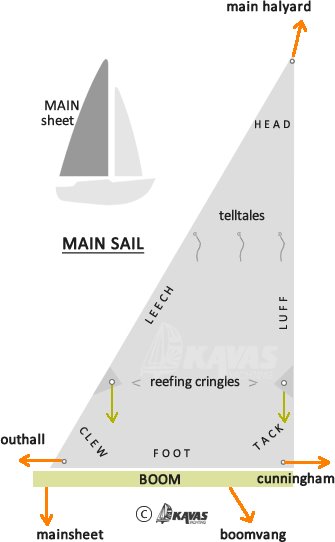Setting sail
Initiating the Journey from the Harbor
Sailing is an exhilarating adventure, and learning the basics is key to a successful voyage.
Raising the sails might seem daunting, but with a few simple steps, even beginners can do it effortlessly.
You will have motored out of the harbour or anchorage and with around 200 - 300 metres of open sea space, between you and the harbour or channel entrance marker buoy, you should turn the boat into the wind and motor gently into the wind.
The Mainsail
The mainsail should be untied from the boom before you leave port / anchorage and your biggest crew member should go to the mast where s/he will find the mainsail halyard.
This will be on the side of the mast at about waist height.
They will haul the halyard until the top of the sail reaches the top of the mast, or when you have a reef in the sail, the halyard is taught.
- Positioning:Ensure the bow points into the wind to minimize wind tension. Steer the sailboat in the wind's direction.
- Attaching the Shackle: Securely attach the shackle to the mainsail's head clew. Tighten it well with pliers to avoid release due to sailing vibrations.
- Loosening the Mainsheet: Release the mainsheet to reduce wind resistance during the sail's ascent. Ensure the leading sail edge faces the wind to prevent strain.
- Halyard Verification: Confirm the halyard readiness and check the shackle's tightness. Accuracy is crucial to prevent delays and challenges in deep waters.
- Preparing for Hoisting: Double-check everything before hoisting to ensure a smooth process. Pay attention to factors influencing hoisting quality.
- Pulling the Halyard:
 Pull the halyard down, checking luff tightness. Verify optimal rope and sail lug functioning. Examine the halyard for any obstructions to prevent issues.
Pull the halyard down, checking luff tightness. Verify optimal rope and sail lug functioning. Examine the halyard for any obstructions to prevent issues. - Using the Winch (If Needed): For larger boats, use a winch to handle the massive mainsail. Carefully wrap the halyard on the winch to hoist the sail without causing damage.
- Cleating the Halyard: Cleat the halyard, ensuring the luff remains tight. A secure luff prevents complications, and cleating ensures stability.
- Ready to Sail: With the mainsail hoisted and secured, you are ready to explore the waters. Sheet the boat to start moving, always prioritizing safety on the water.
THE JIB
The jib is easier to set. It will be on a roller on the forestay.
There will be a jib in-haul on the port side of the cockpit.
When the boat is turned into the wind, take the in-haul off its cleat, and use the planned leeward jib sheet to haul it off the roller. The helm will steer the boat in the direction they want to go and using the winch as necessary, set the sail immediately.
The helm should throttle back the engine and turn it off as you wish.
Off you go!

